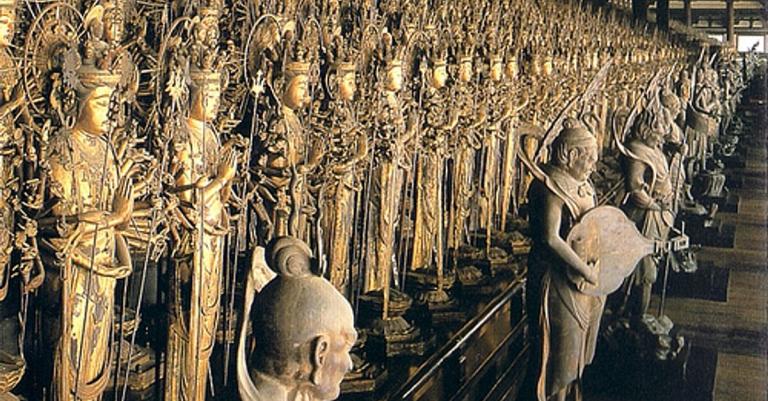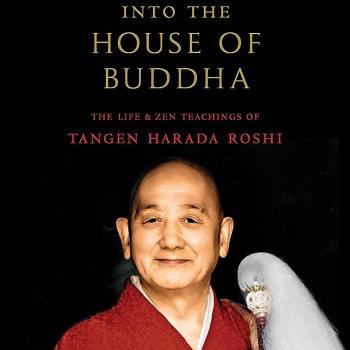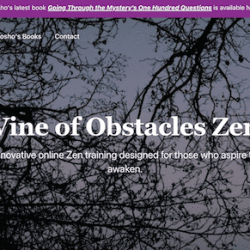Some say this is due to a deficiency in the Zen tradition, but in my view that’s not where the deficiency lies. One cause of this myth is how essential aspects of our liturgy practice have been lost in the transition from Japan to the global culture. Another aspect is a profound misunderstanding regarding what zazen is about in our tradition.
For this second aspect, I’ll turn in a moment to the teaching of Tiāntóng Rújìng (天童如淨; Heavenly Child Pure Suchness; J. Tendō Nyojō; 1163–1228). As part of this myth-busting series, I’m exploring the teaching of some of the buddhas and ancestors in the lineage of Dōgen to demonstrate how they taught the buddhadharma (spoiler alert: not limited to the modern construction known as Sōtō Zen, let alone the Post-Meiji Sōtō Orthodoxy or PMSO™ as I lovingly call it).
So in this post, I’m doing two things. First, clarifying the practice of Great Compassion, and second, offering an example of the teaching of Rújìng.
First things first
In Japanese Sōtō Zen, every morning in almost every Sōtō monastery the liturgy begins with either the prose or the verse recitation from The Lotus Sutra, “Chapter 25: The Universal Gateway of Kanzeon Bodhisattva.” Here’s Taigen Leighton’s translation of the verse:
And in the interest in brevity, there are also the “Four Great Bodhisattva Vows” and the Ten Line Life Prolonging Kannon Sutra (Enmei Jukku Kannon Gyo). Here’s my translation of the later.
Kanzeon
Namo Buddha
One with Buddha cause
One with Buddha affinity
Buddha, Dharma, Sangha affinity
Constancy, joy, self, purity
Mornings nen Kanzeon
Evenings nen Kanzeon
Nen nen through arising mind
Nen nen not apart from this mind (1)
If you are interested in Ten Line sutra, you are welcome to join me for a detailed work-through of it on Saturday, April 30, 2pmET-5pmET, hosted by the Buddhist Temple of Toledo. The workshop is titled, “Disclosing the Hidden Teaching of the Ten Line Kannon Sutra” and is part of their “Celebrating Women in Buddhism” series. Click here for more information.
Now, you or some other nice person might say regarding the compassion sutras in Zen liturgy, “Yeah, well, those are just things that we chant, what does that have to do with practicing or feeling compassion?”
Then I’d say, “Zen liturgy is not just a bunch of cool things we chant. The point is to become the sutra. In this case, Kanzeon, observing world sounds (as well as the sights, tastes, touches, smells, thoughts, and cries, even) – and not just while chanting. The recitation is intended to be the practice and to teach the practice.”
And then that above someone might say, “Do you mean that chanting is a samadhi/absorption practice?”
And I’d say, “It is an absorption-wisdom (samadhi-prajna) practice not apart from sitting, standing, walking, and lying down.”
In the case of Kanzeon, their name is composed of three characters, 觀世音, and the first, 觀, meanings “observing.” That character, 觀, is also the character that is used to translate the Sanskrit vipaśyanā (insight). So “Kan/observing” means much more than sitting back and observing perceptions of the world from a divided subject-object perspective. Chanting with witness consciousness just isn’t it. Instead, the point is to embody the sutra, to become one with the sounds of the world, to practice Great Compassion, before, during, and after the recitation.
So to drop these sutras from our practice, in my view, is a big mistake. The Ten Line is especially ideal for householders and has been practiced with passion by millions of regular folks for more than fifteen hundred years.
However, even without regular recitation of a Great Compassion sutra, there is zazen as Great Compassion. You might notice that in this post I’ve been using both “compassion” and “Great Compassion.” And not interchangeably. Before we get to Rújìng’s teaching on the true heart of zazen as Great Compassion, it seems necessary to first unpack the difference between compassion and Great Compassion.
Another myth common today
is that compassion is a particular feeling. It’s not that this is wrong, but just that it’s limited to compassion as 悲, or karuna in Sanskrit, not Great Compassion. Great Compassion, 大悲, is the compassion specific to bodhisattvas and bodhisattva wannabes like us. Great Compassion is distinguished from compassion (karuna) both by its scope (all beings) and its agency (one wishes oneself to remove all the suffering of all).
So although it is possible and beneficial to generate the feeling of compassion through specific practices, our zazen instead cultivates Great Compassion, observing/being one with all the cries of all the beings. So it simply isn’t a nice feeling that you want so that your identity center is reinforced.
Great Compassion is not necessarily syntonic with the identity center. That is, the cries of all living beings are simply not limited to how you want to feel at any given time.
With that in mind, let’s now turn to the teaching of Rújìng.
The Great Compassion teaching of Rújìng
Rújìng, as you may know, was Dōgen’s teacher. See Punning, Toileting, and Purifying: the Awakening of Rújìng, for more about Rújìng. For the remainder of this post, I’ll focus on one of his short talks, one that Dōgen includes in his Hōkyōki, a record of his conversations with Rújìng.
Here it is in full:
“Although arhats and self-enlightened sages (Sanskrit, pratyekabuddha) do not become attached to their experience in zazen, they lack Great Compassion; therefore they are not the same as the buddhas and ancestors, who considered Great Compassion foremost and practice zazen with the vow to save all living beings.
“The outsiders in India also sat in meditation, but they always had three problems; attachment to the experience, false views, and conceit. Therefore, it is always different from the zazen of the buddhas and ancestors.
“Buddha’s disciples, sravakas, also had sitting meditation, but their compassion was weak; they did not penetrate the real character of all things with incisive wisdom, only improving themselves, they cut off the lineage of buddhas. Therefore theirs was always different from the zazen of buddhas and ancestors.
“What I mean to say is that buddhas and ancestors, from their very first inspiration, practice zazen with the vow to gather together all the qualities of buddhahood. Therefore, in their zazen they do not forget sentient beings, do not forsake living beings. They always have loving thoughts even for insects, and vow to liberate them.
“Whatever virtues they have, they dedicate to all. Therefore, buddhas and ancestors are always in the world of desire practicing zazen and working on the way. In the world of desire, only this world provides the best situation. Cultivating all virtues life after life, one attains to gentility and ease of mind.” (2)
A few points about Rújìng’s teaching
Rújìng can really sing the song of the Universal Mahayana. For Rújìng, our zazen practice IS the practice of Great Compassion, that is, gathering together the qualities of buddhahood to liberate beings, but not waiting for buddhahood.
From one’s initial aspiration, the zazen of buddhas and ancestors is about being one with the cries of the world, liberating living beings. “In their zazen,” says Rújìng, “they do not forget sentient beings, do not forsake living beings.”
How? Our zazen is to constantly BE the cries of the world.
And if Rújìng’s view of zazen was like his Japanese student, Dōgen, and I’d bet the farm that it was, then it had nothing to do with sitting or lying down. Like Dōgen’s zazen, it really isn’t possible to do Rújìng’s zazen without dropping body-mind and realizing who hears, that is, kensho-ing.
Another point is how the old Buddha Rújìng distinguished the bodhisattva path from the paths of those attached to the Buddha’s words, those interested in only benefiting themselves, and those who haven’t yet come into the Buddha’s house and are “…attached to experience, false views, and conceit.”
That applies to all of us any time we are not doing the practice Rújìng describes – gathering the factors of buddhahood and doing our practice, specifically zazen, so that it is the practice of Great Compassion. And for the practice of Great Compassion, this world of desire is the ideal place. Just because it can be so difficult. And so incredibly sublime.
That’s why Compassion Ocean Great Patience (Jikai Dainin) Rōshi used to say, “Before I die, I will put my hands in gassho and vow to be reborn in the human world. Because I love it.”
All that said,
you may read respected Zen teachers asserting that Zen has no compassion practice and that therefore we should import practices from other traditions. I don’t have a problem with importing practices (given that the importer has deeply studied the method with a teacher and isn’t just getting it from written sources), because Zen, after all, as Thich Nhat Hanh often said, is made up of nonZen elements.
However, the notion that the Sōtō Zen tradition and transmission lacks the practice of Great Compassion is simply and verifiably incorrect. It may be the result of a partial transmission suggestive of what Meido Moore Rōshi calls zombie lineages – the walking dead. And if a Mahayana practice lacks both Great Compassion and a focus on awakening, it sure seems likely that the body of practice may be wandering aimlessly about, while the innards rot.
At the very least, it suggests that some essential elements of the Zen way have been lost in transition from Japan to the global culture.
But maybe it’s not too late!
Let’s reinvigorate the Zen Way with the Great Compassion practice of Rújìng!
(1) Translation by Dōshō Port.
(2) Translated by Thomas Cleary in Timeless Spring, A Soto Zen Anthology. Modified.
Dōshō Port began practicing Zen in 1977 and now co-teaches with his wife, Tetsugan Zummach Sensei, with the Vine of Obstacles: Online Support for Zen Training, an internet-based Zen community. Dōshō received dharma transmission from Dainin Katagiri Rōshi and inka shōmei from James Myōun Ford Rōshi in the Harada-Yasutani lineage. Dōshō’s translation and commentary on The Record of Empty Hall: One Hundred Classic Koans, is now available (Shambhala). He is also the author of Keep Me In Your Heart a While: The Haunting Zen of Dainin Katagiri. Click here to support the teaching practice of Tetsugan Sensei and Dōshō Rōshi.













